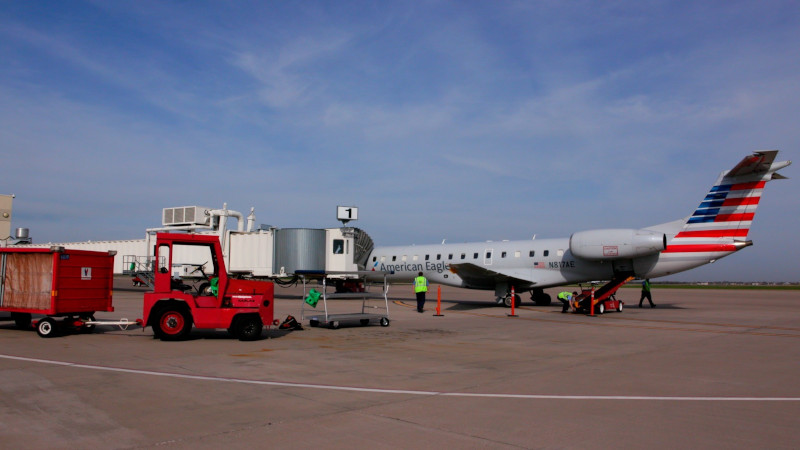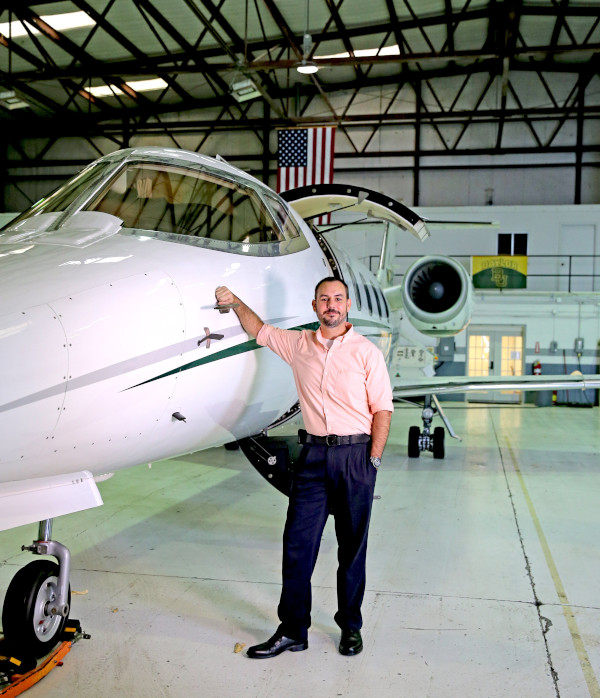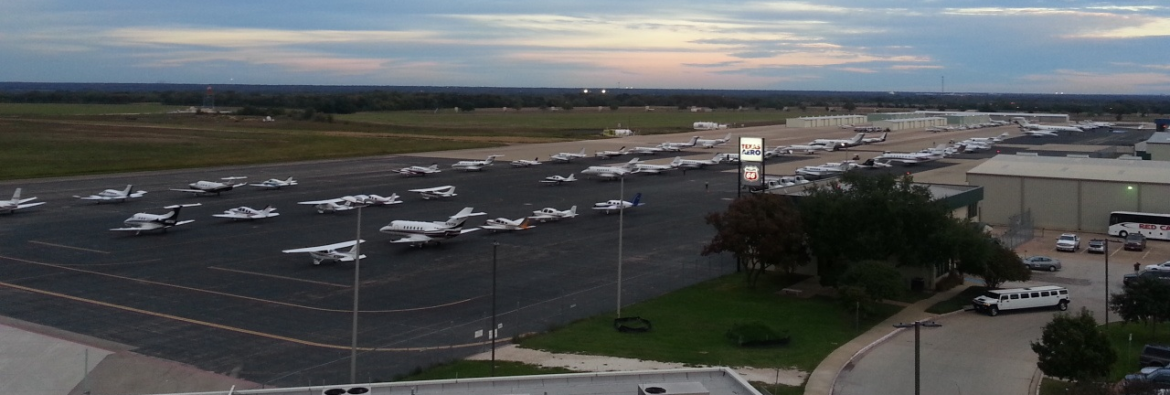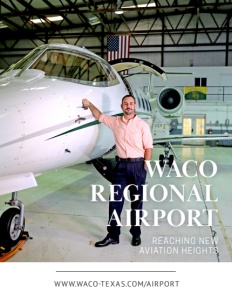Waco Regional Airport
reaching new aviation heights
Enjoying economic growth taking off, Waco Regional Airport is landing increased aviation traffic
With the pandemic left in the jet stream, aviation numbers are souring and regional airports are preparing to meet increased passenger demand. Waco Regional Airport is no exception.
Serving the city of Waco in the heart of the Lone Star State, Waco Regional is situated five miles northwest of Waco in McLennan County, Texas, and is owned by the City of Waco. The airport is strategically located for residents and those flying in about a 10-minute drive from downtown.
We recently caught up with Cody Mathis, Operations Manager with Waco Regional Airport to discuss how this thriving airport is gearing up with infrastructure upgrades.
Placed on the north shore of Lake Waco and possessed of two asphalt runways, with concrete beneath to a depth of some 16 inches to better handle heavy aircraft traffic from large, 63-ton planes, the airport comprises some 1,369 acres, as Mathis informs.
It also boasts two jetways with two gates in use. The airport boasts a10,000-square-foot terminal with a café for passengers to enjoy a well as a Texas Aero building with it own lobby. The airport hosts Texas Aero, its one full-service fixed-base operator (or FBO), well known as a top-notch general-aviation facility that has been in continuous operation for the past 50 years. This popular FBO boasts more than 40,000 square feet of combined hangar and office space.
 “The terminal building is a completely, 100-percent new aesthetic,” Mathis adds of the building, citing everything from bathrooms to lighting, as well as new HVAC units atop the roof.
“The terminal building is a completely, 100-percent new aesthetic,” Mathis adds of the building, citing everything from bathrooms to lighting, as well as new HVAC units atop the roof.
He continues that flight training at Waco Regional is provided by Chiota Aviation; Universal Flight Concepts, which provides both helicopter and airplane training; and Waco Flight Training. The latter specializes in initial tailwheel training and more.
The Airport also sees quite a lot of traffic from military aircraft, such as that of the United States Air Force, and it maintains a contract with the U.S. Department of Defense and the DOD fueling contract is maintained by Texas Aero.
Plus, it does a lot of business with nearby Baylor University, a private Baptist research university in Waco.
Baylor offers a four-year bachelor of science degree in aviation science, as Mathis points out. Waco Regional is home to the Baylor University Flight Center, where flight training is conducted in support of the school’s aviation sciences program. Mathis points out that the flight school makes use of Italian airplanes for training purposes. Baylor’s athletic teams also make use of the airport.
He continues that there is currently one airline servicing Waco: American, by way of Envoy, offering direct service to the Dallas-Fort Worth International Airport, one of the busiest such facilities on earth and a place where you can connect to anywhere in the world.
The aforesaid airlines are subsidiaries owned completely by the American Airlines Group, which is based in Fort Worth, and their largest hub is Charlotte-Douglas International in Charlotte.
“We’re very thankful that we do still have American service here,” Mathis adds of the airline.
Infrastructural characteristics and coming improvements
To prolong their effective use, airports have to be regularly maintained and updated. One such effort for Waco Regional is improving its aprons. According to the Federal Aviation Administration, aprons are areas of airports where aircraft are parked, unloaded or loaded, refueled, boarded, or maintained. Mathis says aged asphalt is being replaced by concrete as part of a three-phase operation.
He adds that later this year, an airfield drainage project will kick off. Coming into 2024 and ’25, airport officials are looking at overlaying the runways.
Further, getting an MRO (or maintenance, repair, and overhaul) facility at Waco Regional “would be fantastic,” Mathis observes, adding that Texas Aero is looking to expand corporate hangar storage space very soon.
Being placed right outside of the Interstate-35 corridor is particularly advantageous for the airport, as Mathis points out. According to the Texas Department of Transportation (or TDOT), I-35 is a major north-south route that runs from Laredo near the Mexican border to the Red River north of Gainesville, where it crosses thence into Oklahoma.
Along its route, it passes through the cities of San Antonio, Austin, and Waco before it splits in twain, forming auxiliary routes just north of Hillsboro. Further, also according to the TDOT, I-35’s eastbound route heads northeast. There it traverses through Dallas, and its westbound route turns northwest to run through Fort Worth.
With such positive infrastructural characteristics, the airport is uniquely situated to be a boon economically for the entire region, as Mathis notes.
“Waco Regional is the spot to be,” he remarks.
 The future and the past
The future and the past
Looking ahead to the next decade, Mathis opines that getting some competition for Texas Aero would be a good thing. He adds that it’s not good to have one FBO seemingly monopolizing things at a regional airport, so such competition would be healthy for capitalism and good for business.
As well, he adds, “It would be nice to get a piece of the cargo pie.”
Yet there’s plenty of room to develop that at Waco Regional, as Mathis points out. He adds that Amazon, the famous retail giant, just opened a big warehouse facility right down the road from the airport, and the two would potentially be a great fit.
“It would be fantastic to collaborate with Amazon and get some of their aircraft coming through here,” he observes.
The biggest near-term interest is courting a second airline. Not only would this mean giving customers another option for travel, but it also would mean, again, that all-important concept so vital to a healthy business climate: competition.
Mathis cites cost-benefit analyses. One of them concerns parking. Waco Regional offers free parking, and Mathis notes that this can be a major attractor for many fliers seeking to avoid the fees the jet set may find easier to swallow.
“You might have to pay a parking bill, just to get out of that joint, for who knows how much,” he observes, citing Dallas-Fort Worth and other such international airports, adding that, “It’s a great selling point. Our parking lot stays pretty full.”
Turning from the future and back to the past, Mathis discusses Waco Regional’s history. The facility goes back more than 80 years, and it began its life as a training center for what was then the U.S. Army Air Corps (now the Air Force) during World War II. Construction for what was at the time to be the Waco Municipal Airport began in 1941.
However, in the early part of 1942, not long after Pearl Harbor, the U.S. War Department leased the site, and it was given to the Air Corps for use as a training airfield. At that time, construction consisted of three runways only partially completed.
Yet as so often happened during the necessary haste involved in America’s wartime efforts, the Air Corps began to rush the project to fruition, and it soon changed the civil building plans to that of a military airfield and ground station. Barracks, mess halls, a hospital, a church, a cinema, administrative buildings, aircraft hangars, and a control tower were all constructed.
At first, the facility was called the China Spring Army Air Field (a nod to native Texan Claire Chennault and his famed Flying Tigers squadrons; the fighter pilots trained in Texas before going overseas to defend the Chinese Republic from Imperial Japan). It later became known as Waco Army Airfield Number Two before being renamed the Blackland Army Airfield––a reference to the local area’s black soil.
Activated in ’42, Blackland was at first a school for training glider pilots in nine weeks. It used many two-engine trainers, such as the Cessna AT-17 “Bobcat,” the Curtiss-Wright AT-Nine, the Beechcraft AT-10 “Wichita” and the TB-25 Mitchell.
The Waco Regional Airport has come a mighty long way since that time, and these days, as Mathis says, it’s smooth sailing and onward and upward.
“It’s got roots,” he says. “It’s got history. It’s a long-standing facility, but it’s also a modernized facility that has all the features and amenities you’d be looking for.”
Whether you’re a tourist looking for a good deal on a flight, or you’re an aviation entity, looking to expand your business, Waco Regional has a choice that’s right for you, as Mathis emphasizes.
“We have the room.”
“It’s fantastic,” he concludes enthusiastically.



